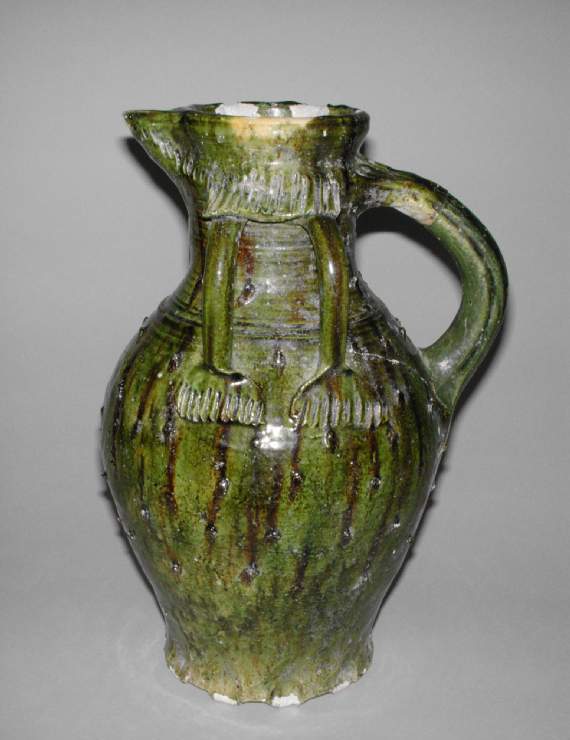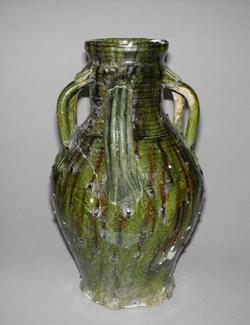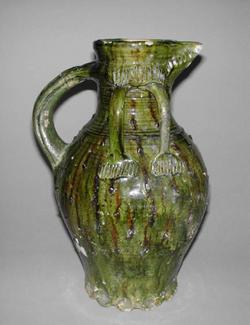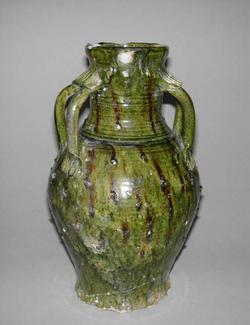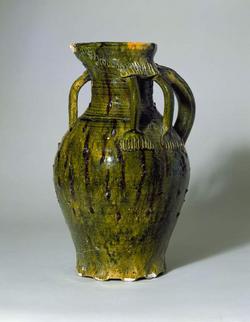Current Location: Gallery 27 (Glaisher)
Maker(s)
Pottery:
Unknown
Entities
Categories
Description
Buff earthenware, thrown, with applied decoration, partially covered with iron-flecked lead glaze. The jug is of oviform shape, with applied points of clay on the sides, and frill resembling hair or a beard round the upper neck below which two arms on each side curve downwards to the shoulder and terminated in comb-shaped hands. The base has been thumb pressed into scallop projections, forming a foot ring. The handle is restored.
Notes
History note: Found in a passage under Mr Gretton's house in St Paul's Street, Stamford; Stamford Museum; purchased by Mr William Edinborough & Sons, Broad Street, Stamford at the Stamford Museum Sale, 1 June, 1910 for £4.4s.0d. on behalf of Dr J.W.L. Glaisher, FRS, Trinity College, Cambridge
Legal notes
Dr J.W.L. Glaisher Bequest
Measurements and weight
Height: 32.4 cm
Acquisition and important dates
Method of acquisition: Bequeathed
(1928-12-07)
by
Glaisher, J. W. L., Dr
Dating
13th Century, second half
Circa
1250
CE
-
1300
CE
Note
A pottery industry developed at Scarborough after the founding of the castle during the reign of King Stephen (1135-54), and flourished until the mid-fourteenth century, when the town declined in importance. The pots were made of a reddish, pinkish-buff or off-white clay fabric, depending on date, and green or yellow lead glazes are typical. As well as food containers, such as pipkins and bowls, the potters made aquamaniles in the shape of animals, and large jugs exuberantly decorated with modelled knights on horseback, or with bearded masks and arms below the spouts. Others were less extravagantly decorated with applied scales, strips and pellets of clay.
Excavated and chance finds have shown that Scarborough ware was exported to many places in north- and south-eastern England, and as far away as Aberdeen, Bergen and Bruges. This jug was found under a house in St Paul's Street, Stamford, Lincolnshire. Part of its handle has been restored, but it is otherwise remarkably well preserved. A jug of this kind was probably used for serving drinks or for hand washing at meals. Plainer jugs were used for fetching water from wells and taking drinks to labourers in the fields. When full they were fairly heavy and in illuminated manuscripts are shown being carried on the head or shoulder.
School or Style
Medieval
People, subjects and objects depicted
Components of the work
Part Of Body
composed of
lead-glaze
Body
Decoration
Materials used in production
Earthenware
Inscription or legends present
- Text: Large mediaeval vase found in a subteranean passage beneath Mr Gretton's house, in St Paul's Street, Stamford, while excavating for foundations.
- Method of creation: Hand-written
- Type: Label
References and bibliographic entries
Identification numbers
Accession number: GL.C.11-1928
Primary reference Number: 77021
Old object number: 3134
Duplicate: [dup] Gi.C11-1928
Stable URI
Audit data
Created: Saturday 6 August 2011
Updated: Tuesday 21 October 2025
Last processed: Tuesday 21 October 2025
Associated departments & institutions
Owner or interested party:
The Fitzwilliam Museum
Associated department:
Applied Arts
